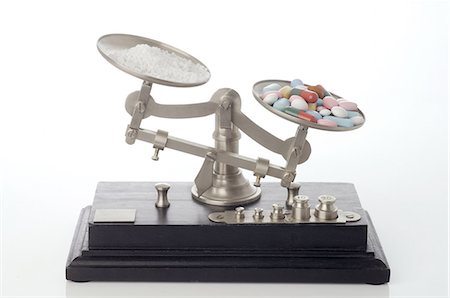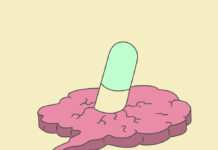A recent editorial in Psychotherapy and Psychosomatics hopes to call attention to iatrogenic harms that service-users can experience as a result of psychiatric treatment. The authors define iatrogenesis as the side effects and risks associated with medical intervention, including medical error, adverse drug reactions, malpractice, and negligence. Psychiatric iatrogenesis typically manifests as complications of psychotropic drug treatment such as tardive dyskinesia, insulin resistance, cardiac/metabolic disturbances, and result from direct toxicity, intoxication, withdrawal, or drug interaction.
The editorial argues that psychiatry has traditionally been evaluated in terms of how well it improves psychiatric symptoms, with little focus on the negative psychological and behavioral impacts of the treatment and with side effects accepted as an inevitable shortcoming to treatment. The authors, Giovanni Fava, a psychiatrist and professor at the University at Buffalo, and Chiara Rafanelli, a psychiatrist and professor at the University of Bologna, write:
“Current classification systems in psychiatry fail to consider the iatrogenic components of psychopathology related to behavioral toxicity. Affective disturbances caused by medical drugs, as well as paradoxical effects, manifestations of tolerance (loss of clinical effect, refractoriness), withdrawal and post-withdrawal disorders, are increasingly common due to the widespread use of psychotropic drugs in the general population. Such neglect is serious since manifestations of behavioral toxicity are unlikely to respond to standard psychiatric treatments and may be responsible for the wide spectrum of disturbances subsumed under the generic rubric of treatment resistance.”

Clinicians have long been aware of the need to consider the effects of psychotropic drugs on the symptoms of the disorder at hand. It was not until the ’90s, however, that a review of residual symptomology of psychiatric drug treatment emerged, begging the question as to how a limited number of enduring symptoms in long-term antidepressant users, insufficient for clinical diagnosis, should be evaluated.
Detre and Jarecki proposed the rollback phenomenon, wherein, as an illness remits, there is a progressive repetition of symptoms and stages in reverse order as to how it developed. It has since been argued that the reduction or removal of residual symptoms may result in better long-term outcomes, which favors sequential treatment.
DiMascio and colleagues defined behavioral toxicity as the action of a drug that, within the range of clinical utility, produces changes in mood, perception, cognition, and psychomotor function, thereby limiting the capacity of an individual or constituting a hazard to their well-being. They also introduced paradoxical drug effects, which are mood alterations opposite to the clinically desired outcome, and pendular drug effects, which initially proceed in the direction intended but do so to such an extent that the individual’s state moves to the opposite condition for which the drug was prescribed.
These concepts, the authors contend, received little attention in scientific literature until fairly recently. The authors further argue that withdrawal can constitute a form of behavioral toxicity and can range from mild, spontaneously recovering symptoms to pervasive, long-lasting symptoms. The occurrence of withdrawal seems unaffected by tapering, and after the loss of clinical effect, dosage increase is unlikely to restore a response.
There has long been debate as to how medications can impact pharmacodynamics long after medication cessation, though Baldessarini noted that long-term changes might occur at the levels of receptor plasticity, neuronal firing, transmitter synthesis and genetic control of neuronal function. Follow-up on these concepts has been scant, and it remains unclear whether pharmacodynamic changes from medication are reversible.
The oppositional model of tolerance argues that continued drug treatment may lead to processes that oppose the initial effects of a drug, which may cause illness to become more malignant and unresponsive to treatment. If treatment is ceased, the oppositional processes have no further resistance, which results in new withdrawal symptoms, rebound symptoms, and treatment resistance, among other effects.
Feinstein’s definition of comorbidity is any distinct clinical entity that exists or occurs during the clinical course in addition to the disease being studied. Iatrogenic comorbidity, meanwhile, refers to modifications in the course, characteristics, and response to treatment as it relates to previous therapy, and may explain resistance to a drug that was previously effective, the persistence of side effects, or the emergence of new symptoms.
“[T]he ill-defined concept of treatment resistance is based on the untested assumption that treatment was right in the first place and failure to respond is entirely shifted (and implicitly blamed) upon patient characteristics,” write the authors.
Cascade iatrogenesis is the concept that the development of multiple medical complications can progress following an innocuous first event. When symptoms of behavioral toxicity are misinterpreted or ignored, cascading events can lead to the deterioration of illness, simply from the choices of the clinician.
As the frequency of drug use and polypharmacy increases, the assessment of medication burden and polypharmacy becomes increasingly crucial in psychiatric evaluations. Current DSM and ICD definitions assume a drug-free patient, a patient who is increasingly unlikely to exist as most psychiatric cases in clinical practice involve some drug treatment. This can result in a lack of emphasis on collecting information related to previous treatment and reflects an essential growth edge in psychiatry.
A crucial first step must be to evaluate the efficacy as well as the behavioral toxicity of previous psychotropic medications. Then the clinician places that information in the context of psychiatric and medical morbidity. Traditional clinical taxonomy doesn’t include iatrogenic considerations as they relate to behavioral toxicity. The authors argue instead for a concentric model of pathways, wherein psychological, biological, social, and iatrogenic factors form a concentric web, all contributing to the clinical condition. From there, the authors suggest macroanalysis, which first assumes functional relationships among problematic areas that will fluctuate during the course of symptomology.
Incorporating iatrogenic factors, previously ignored in psychiatry, will require a renaissance of psychopathology and scrutiny of current conceptual models. To do this, the authors make several guiding comments.
- First, the authors argue that withdrawal symptoms can often be misinterpreted as a sign of relapse. Their diagnosis, instead, requires the collection of new symptoms not part of the previous symptomology, though this issue is complicated by the coexistence of relapse and withdrawal symptoms.
- Second, it is important to distinguish non-response to new treatment from tolerance to previous therapy or loss of response during maintenance therapy.
- Third, identifying secondary or symptomatic affective disturbances may have critical implications for drug-induced psychiatric syndromes; the authors suggest considering such syndromes drug-related until proven otherwise in cases where medical agents produce accordant psychiatric symptoms.
- Fourth, the authors argue that we must consider whether antidepressant treatment or depression causes post-withdrawal disorders, and which is responsible for increased secondary comorbidity.
- Finally, as Richardson and Doster suggest, the authors invite consideration of baseline risk of the index disorder without treatment, treatment responsiveness, and vulnerability to adverse treatment effects when making an evidence-based medical decision. This should be tailored to each patient, thus moving away from strict reliance on diagnostic criteria.
“The notion of psychiatric disease is no longer in line with the changed spectrum of health and the complex interplay of biological, iatrogenic and psychosocial factors,” note the authors.
“Consideration of iatrogenic factors challenges most of the current practices of prescription of psychotropic drugs. Recognition of iatrogenic factors in psychopathology runs counter major commercial interests, and not surprisingly is censored in mainstream medical journals, scientific meetings, and guidelines.”
The authors argue that a commitment to evidence-based medicine and the marketing of the pharmaceutical industry are currently the primary drivers of psychiatrists’ decision-making. Instead, the authors urge psychiatrists to use their already complex clinical judgment and interviewing skills to understand iatrogenic components of psychopathology.
****
Fava, G. A., & Rafanelli, C., (2019). Iatrogenic Factors in Psychopathology. Psychotherapy and Psychosomatics, 14, 1-12. doi: 10.1159/000500151 (Link)















Let’s also not forgot iatrogenic harm from psychotherapy.
Report comment
https://medical-dictionary.thefreedictionary.com/iatrogenic
Gavin, I’m having a hard time discerning what your position is. Psychiatry has no legitimacy to it at all and it should not be tolerated under any circumstances.
Report comment
“LET WISDOM GUIDE” – At last, some WISDOM.
Report comment
Thank you. This is worth memorizing so users and allies can use precise, clinically relevant language to describe the many manifestations of iatrogenic harm in front of a psychiatrist who is willing to listen.
Report comment
I guess it’s becoming harder to conceal the damage done by these drugs.
Too little too late.
Report comment
When “iatrogenic components of psychopathology” are pointed out to the psychiatrists, like Whitaker did in “Anatomy of an Epidemic.” Where he pointed out the two iatrogenic pathways to a “bipolar” misdiagnosis, via both the ADHD drugs and antidepressants. Despite this clear disclaimer being in the DSM-IV-TR’s “bipolar” definition:
“Note: Manic-like episodes that are clearly caused by somatic antidepressant treatment (e.g., medication, electroconvulsive therapy, light therapy) should not count toward a diagnosis of Bipolar I Disorder.”
The psychiatrists’ response to Whitaker – and the world – was, NOT to add the ADHD drugs to that disclaimer, as would have been the ethical thing to do. But, instead, the psychiatrists took that disclaimer completely OUT of their DSM5.
And the psychiatrists don’t list either neuroleptic induced deficit syndrome or antidepressant and/or antipsychotic induced anticholinergic toxidrome in any of their DSMs. Despite the fact these two medically known, psychiatric drug induced syndrome/toxidrome create both the negative and positive symptoms of “schizophrenia.”
https://en.wikipedia.org/wiki/Neuroleptic-induced_deficit_syndrome
https://en.wikipedia.org/wiki/Toxidrome
Meaning most so called “bipolar” and “schizophrenia” are likely iatrogenic illnesses created with the psychiatric drugs. In other words, the entire psychiatric system – including the “sacred symbol of psychiatry” – is based upon creating iatrogenic illnesses in people with the psychiatric drugs.
Psychiatry has a proven track record of denying the iatrogenic harms of their “wonder drugs.” And their recent behavior has proven that, as a group, the psychiatrists actively work to cover up the iatrogenic harm they are doing to their clients.
The US founding fathers understood the importance of checks and balances on power. Checks and balances are needed on our “mental health” workers. Giving anyone, including all psychiatrists, the right to individually play “judge, jury, and executioner” to other human beings is unwise, and un-American.
I’m grateful to the psychiatrists who are pointing out the need to look at the iatrogenic harm, that the psychiatric industry collectively is participating in; especially since it truly seems to be at way past “holocaust” levels already.
https://www.naturalnews.com/049860_psych_drugs_medical_holocaust_Big_Pharma.html
Report comment
Thank you MIA for this article.
What first comes to mind are a couple of questions:
1) Whereas psychiatrists are dually certified medical doctors; what is the mandate on continuing education for understanding, recognizing and applying: the “loading dose” and half-life of the chemicals they are supporting through the “power of the pen” of prescriptions?
2) Would this subject be best addressed at the State level or Federal?
Thanks in advance for any feedback.
Report comment
Here’s the thing: if the content of those continuing education credits is ghostwritten, or outright provided, by Big Pharma, mandating that they receive it ain’t doing the potential victims of iatrogenic harm any favors!
Report comment
Removed for moderation.
Report comment
Well this pretty much explains my childhood and why I’m still a brain damaged disabled miserable bum, counting the months (23) to my next CDR for SSI where I’m re-abused and traumatized all over again in order to get a tiny pittance that for a whole year isn’t what a medicaid funded psychiatrist gets in just a few weeks (literally – 9,000 a year compared to 160-220k a year), yet I’m supposed to be in “treatment” all these years, racking up millions of dollars in medicaid costs throughout my life, so the people that ruined me in the first place can live upper class lives while I’m shamed for occasionally buying some decent food like digornio pizza with my bridge card.
Report comment
You got that right Jeffrey!
Never wanted to be a lab rat for a career. Not my choice.
The APA claims their pills turn bad people good and irresponsible people productive. Yet their magic wonder drugs work by shrinking the frontal cortex (impulse control) and amygdala (altruistic behaviors.) How’s that supposed to work?
Report comment
JeffreyC, we need to stop talking about Psychiatry, Threapy, and Recovery, and start standing up for the scapegoats of the middle-class family, wining some public victories, because that and that alone is what will restore our public honor.
Report comment
But Gavin, why do you even care what Psychiatrists are talking about? I only care how fast they can be eradicated.
Report comment
Jeffrey, your comment reminded me – a fellow brain damaged disabled miserable bum – that when my SSDI comes up for review again, I won’t be able to to pass the forms on to my “treatment providers” so they can write notes about how completely disabled I still am, since I have now quit any and all type of mental health treatment. I’m planning to answer the questions on the forms honestly, with something along the lines of, “After decades of abuse by the mental health system, I quit. Even in the unlikely event that any psychiatrist/psychologist would still be willing to treat me after all the complaints I filed and reviews I posted, I would refuse treatment. I won’t ever be a mental patient again.” I don’t know how that’s going to play but they can take away my disability if they have to. I’m not doing that anymore.
Report comment
Of course that would not work. They will tell you that they have to evaluate based on recent medical records, they will send you to consultative exams that will most likely lead nowhere except to a technical continuation of benefits for you to seek and receive “treatment” before they come to their “final” decision.
Report comment
I’m sure you’re right, Jeffrey. There is a strange way in which I’m almost looking forward to it. I’m sure this is not a healthy response on my part. Now that I’ve finally woken up to what they put me through, and realizing (with one or two exceptions) none of these people had positive intentions toward me, I want to “get into it” with them. I want a verbal confrontation. Even knowing that the best thing for me is to forget all of it, forget all the treatment induced trauma…it’s hard to do. I have a very hard time putting it out of my mind. It was 35 years of my life.
Report comment
KateL, we need to start winning some public victories, because that is what will restore out public honor.
The only good at this point in Psychiatry, Psychotherapy, and Recovery, is that we can score points by taking them down.
The bigger issue is the Middle-Class Family and its Self-Reliance Ethic. But harder to find people willing to act here.
Report comment
Pacific Dawn, I agree about public victories…yes, we need them. Not sure what it would look like…there have been class action suit against the makers of cymbalta, but that’s maybe more about money. I’m in cymbalta withdrawal now, for the last 6 months, and it’s hell. I can be standing next to a blaring TV and the ringing in my ears is still louder than the TV. I’ve thought about writing a book about my 35 years worth of Psychiatric hell but not up to anything yet. First I need some private victories. I think Rachel said “for some the only way out is a casket”. I wonder if I’ll ever get some kind of life back. I’m not suicidal, at all, but I feel like hell mentally and physically and have no support. I don’t enjoy people anymore and basically avoid them like the plague. I don’t need anyone telling me to get back on meds or whatever “helpful” advice they would give. If I had a bazillion dollars I would open a post-psychiatric retreat center and would be the first guest. I saw that there’s a psychiatric survivor group in Vermont – I think they have IRL meetings and such. I wish there were something like that in my state. I think that would be a good start, to have more things like that?
Sorry, this is a bit rambling.
Report comment
Comment removed for moderation.
Report comment
“Psychiatrists Argue For More Attention to Iatrogenic Harms”
Well lets let them explain that at their Crimes Against Humanity trial.
In the mean time, don’t converse with them or say anything which legitimates them.
Report comment
Removed for moderation.
Report comment
Psychiatric treatments = iatrogenic harms.
If they don’t harm they don’t work. Period.
Report comment